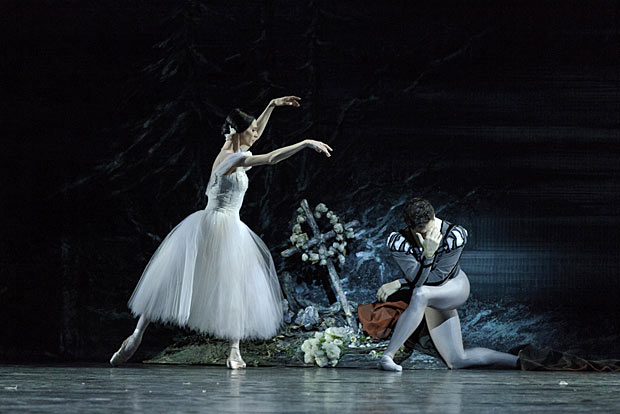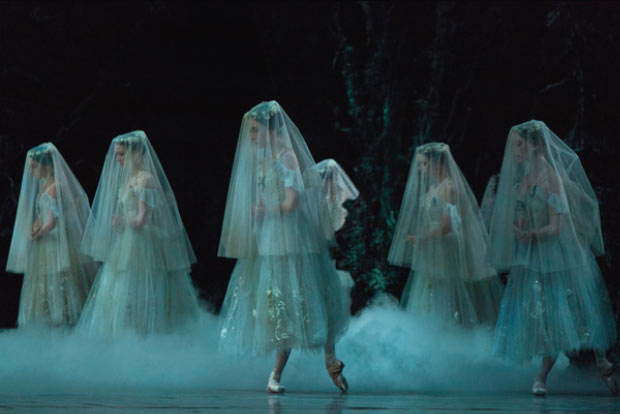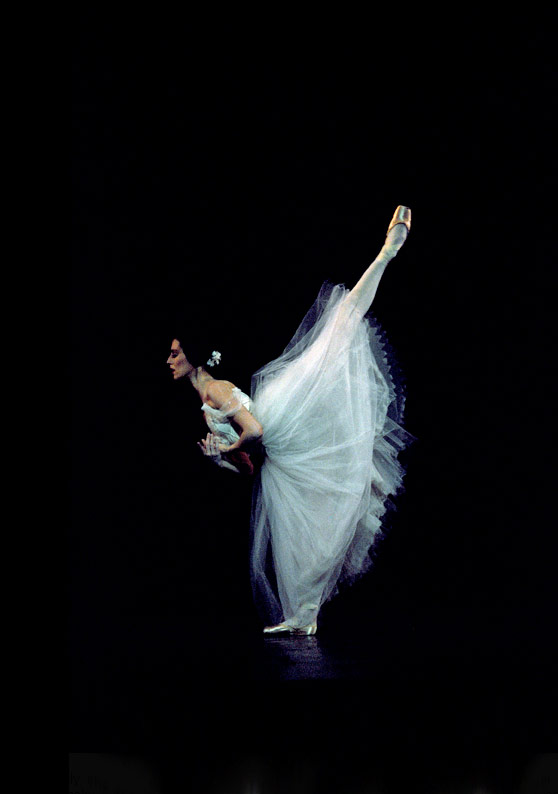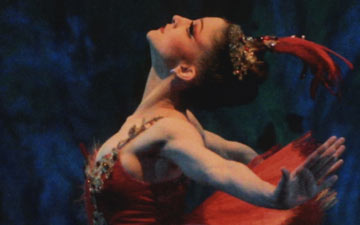
© Aleksandar Antonijevic. (Click image for larger version)
National Ballet of Canada
Giselle
Saratoga Springs, Performing Arts Center
17, 18 July 2013
national.ballet.ca
www.spac.org
If you can’t see the enchanted forest of A Midsummer Night’s Dream at the Saratoga Performing Arts Center’s semi-outdoors theater-in-the-woods, the haunted arbor of Giselle’s second act is a worthy substitute, especially when performed by the National Ballet of Canada. Thursday (the 18th), as Heather Ogden folded herself into the magisterial penchée introducing what would prove to be a sizzling Myrtha on a sizzling night, her accompaniment from the orchestra’s excellent violinist was augmented by the warbling of birds nesting in the vast theater’s rafters. Later, as the ghostly wilis formed their deadly evolutions, a cloud of winking fireflies floated through the house, extending the onstage magic to, in one case, just beyond the tip of my nose. While Ogden marshaled her troops against that act’s darkening woods, the post-sunset strip of sky visible above the countless trees encircling the open-sided theater matched perfectly that of the set’s Maxfield Parrish blue. You could hardly feel more enfolded by the mysteries of that act’s night had you been onstage yourself.
While some might consider the Canadian’s brief visit to Saratoga small compensation for the shrinking of SPAC’s venerable summer season of the New York City Ballet from two weeks to a paltry one (especially if they’d seen the opening bill, featuring James Kudelka’s The Four Seasons), the two Giselles I saw revealed a strong company with a thrilling, exuberant style that prompted a friend to say, “I’d go to Toronto to see this!” and if that’s not a ringing endorsement, I don’t know what is. Apart from their artistry, I must particularly commend the Canadians for their professionalism in performing in a non-air-conditioned theater during a brutal heat wave, with temperatures as high as 99 degrees (fahrenheit, 37 celsius). I can only imagine how murderously hot it must have been beneath the stage lights, or in the orchestra pit.
As this Giselle was staged on the company in 1970 by Peter Wright, I’d expected it to look much like the Royal Ballet’s current one, also staged by Wright. It does in most ways, for better (Giselle indeed stabs herself to death during her mad scene, giving a reason why she, as a suicide, wouldn’t have been buried in a churchyard) or worse (Berthe’s mime warning Giselle about the wilis, with its introduction of the wilis’ leitmotif in Adolphe Adam’s score, is gone, as is Wilfred’s prudent warning to Albrecht early in the second act), but some touches seem different, and not always felicitously.
While most of these parts – especially an expanded role for Myrtha which sees her far more involved in ordering her would-be victims about rather than spending most of the second act gesturing imperiously from the downstage left corner – might be considered improvements, or at least not-awful, by those who don’t necessarily consider themselves hide-bound traditionalists, the ballet’s conclusion is sadly misguided, and not at all what I recall from the Royal’s. Rather than tenderly (and futilely) attempting to carry Giselle away from her grave, Albrecht walks arm-in-arm with her down a long diagonal, not noticing until he reaches the downstage left corner that she’s long since bourreed away. He turns upstage in time to witness her, not returning in some fashion to her grave, but bourreing prettily backwards into the upstage right wing, near her grave.
So, instead of the familiar and poignant parting which has her slipping delicately from his arms at her grave, here Albrecht has his last glimpse of her from the long diagonal from downstage left to upstage right – he couldn’t be any farther from her unless he was standing in the orchestra pit – which reinforces our growing suspicion that he’s not the sharpest pencil in the box. Worse, as Albrecht performs his downcast, flower-strewing walk towards the lowering curtain, Giselle appears again, high among the upstage trees, gesturing sadly (I assume) after him. Dead heroine high among the upstage vegetation as the curtain falls? Is this Giselle or La Sylphide? This not-quite-dead-yet apparition of an apparition throws out much of the ballet’s dramatic coherence for a cheap bit of melodrama. (Is she not back in her grave like a good wili? Or does Wright doom her to an eternity moping in the woods?)
However, with one glaring exception, the Canadians danced so marvelously I found myself loving Wright’s better enhancements, and hardly minding his less fortunate ones (I’ll get to the exception in a bit). The first things I noticed about this production were the quality of the orchestra, apparent at even the overture’s beginning, and, after the curtain rose, that this staging uses very large legs to shrink the actual area in which the dancers perform by perhaps a third of the SPAC stage’s width (the same as NYCB’s Koch Theater in New York), that is, within a smallish set on a biggish stage. I wondered if the Canadian’s home stage is of such modest proportions, or if their touring production is scaled for smaller stages. Regardless, it’s an odd artistic decision, which at times makes the stage look overcrowded, and the dancing cramped, as when Albrecht chases Giselle as both circle the stage with grande jetés. At times those jumps seemed barely to travel at all, as did the celebrated arabesques voyagées of the wilis in the second act, during which, at times, they seemed reduced to hopping in place (and doing so quite beautifully). Whatever the reason might be for this shrinkage, it seemed an odd choice, especially given the Canadian dancers’ brio and fondness for big, traveling jumps (the entire corps jumps splendidly), and SPAC’s accommodatingly large stage.

© Aleksandar Antonijevic. (Click image for larger version
Perhaps I should address those jumps now as they set much of evening’s tone, along with Joseph Horovitz’ lively adaptation of Adolph Adam’s 1841 score. This latter was lit in musical bas-relief by David Briskin’s sprightly and sensitive conducting – a high-contrast mode in which allegros seemed a bit zippier, and adagios concomitantly grander, than I’m used to from ABT’s orchestra, which often seems relieved to have made it to the end of an evening in one piece. With Adam’s allegros presented in clear, almost contagiously affecting beats, I often had to force my hands down to keep from conducting along with Briskin (I’m a terrific conductor when no one’s watching). I also became quite taken with the Canadian dancers’ way with these emphatic beats and tempi, blowing away any lingering, decades-old perceptions I might once have had of the Canadian style as a sort of Royal Ballet manqué (whether that best describes today’s Royal is a question for another time).
Dancing on top of the beat with a musical alacrity that reminds me a bit of City Ballet’s, the Canadians seemed to make that beat manifest as a propulsive force you could almost feel in your gut as much as see in their leaps onstage, especially in the profoundly jumpy second act. Until now, I’d always considered any dance style conjoining both Giselle and pogo sticks to be profoundly unfortunate (*cough* Osipova *cough*), but here I was enjoying their buoyancy which brought that very thing to mind, and happily so. Again and again in Giselle, you see jumping combinations which include the very common steps of a big assemblé followed by a big sissonne. I don’t think I’ve ever been so conscious of a dancer repeatedly bringing his feet together in an assemblé, straightened legs pointing like an arrow (or missile) to the imminent landing spot, then land sinking into a deep plié such that you can almost see energy from that connection to the floor being stored into the elastic springs of his hamstrings, calves and quadriceps, then immediately released as he straightens his legs into the sissonne and resumes his airborne progress.
These jumps brought to mind indeed the accumulation and release of energy in a pogo stick or trampoline, but marvelously so, with these bounding leaps timed so you could almost feel the dancers being impelled along by Adam’s score and Briskin’s baton, in the sympathetic and affecting way we feel within ourselves echoes of movement and rhythms we see in others. I felt it again and again, whether the leapers were the corps womens’ very aerial villagers and wilis, Keiichi Hirano and Skylar Campbell doubling up in the man’s role of what was once the Peasant Pas de Deux, Greta Hodgkinson’s ghostly Giselle and, most strikingly, Heather Ogden’s ever-attacking Myrtha (this cast from the first Giselle I saw, Wednesday the 17th). Whether this infectious, athletic way of jumping is a hallmark of current Canadian style, or just their delightful way with Giselle, I can’t say, but it’s distinctive and appealing; I grew to love it by the end of my second Giselle at SPAC.

© Aleksandar Antonijevic. (Click image for larger version)
So, about the performance itself? Desmond Heeley’s sets, of the familiar autumnal village, are as effective as they are conventional; so are his costumes, with the exception of the otherwise-lovely costume for Myrtha which occasionally makes her look like the Sequin Fairy. As Giselle, Greta Hodgkinson was a revelation. A mature artist fully in command of her technique and presentation, she gave one of the finer performances I’ve seen in recent years. While also a conventional portrayal of a good and somewhat naive girl and her fatally rude awakening to Albrecht’s would-be philandering, her Giselle was a compelling picture of technical strength leavened with artistic discernment. In the first act, she was appropriately love-struck by Guillaume Côté’s blandly handsome Albrecht, her playful vivaciousness tinged with just enough insecurity to show you why she’d pick his slick eye candy over the rougher-hewn but sincere Hilarion of Piotr Stanczyk. From her first ballottés I was struck by the precision of her footwork (not every ballerina shows such careful placement of the front foot as it pulls back to kiss the quickly departing back ankle) and the suppleness of her arches. In the Spessitseva solo, she rolled down through her standing foot from the opening piqué arabesque penchée with a softness and control that brought to mind that of Gelsey Kirkland in her stunning performance of the same solo which you can find on the Internet today. (Also, like Kirkland, Hodgkinson’s ankles are almost alarmingly thin.) Her meticulously acted mad scene made searingly clear what Giselle was seeing and thinking; her startled confusion after stabbing herself with Albrecht’s sword (a key element of Peter Wright’s staging) was particularly poignant.
Throughout, and especially in the second act, I was impressed by what she didn’t do as much as by what she did. Her turns on a diagonal towards Albrecht in the first act didn’t sacrifice control for showy speed, and, in the second act, moments in which ballerinas more familiar in New York might’ve hit you over the head with their virtuosity (see *cough*, above) seemed deliberately underplayed. While she was suitably impressive in Giselle’s outside turns in attitude at her first manifestation as a wili, the succeeding jumps were only lightly histrionic. In her allegro solo before Myrtha and the wilis, her side-to-side glissades and ronde de jambe en l’air sautés were so low and small as to barely skim above the stage’s surface, and her subsequent kicking-up-the-heels soubresauts were so low-key they registered more as harmonious musical accents to her solo than the all-too-familiar, incongruous bunny hops. I enjoyed this careful and intelligent modulation of effect by Hodgkinson, which allowed her truly big moments, like her lily-tossing grand jetés into the wings, to read better as such (although part of the credit must be laid to Wright’s relentlessly tasteful staging, in which poor Albrecht’s own Big Moment is reduced to a piddly eleven entrechats six). While Hodgkinson did not overtly show us Giselle’s second-act persona as a struggle between the ghost she is and the girl she was, the truly adoring gaze she fixed on the kneeling Côté while bourreeing behind him into the final pose of their adagio was a touching testament both to Giselle’s love, and the sad fact that death had done nothing to improve her power of observation.
National Ballet of Canada’s Giselle danced in 1976 by an earlier generation – Karen Kain (now Artistic Director of the company) and Frank Augustyn. (Full video from Vai)
Nothing epitomized this performance’s forward-leaning musicality and springy ballon more than Heather Ogden’s fierce Myrtha. There are two kinds of Myrthas in the world: the regal, cold (and usually tall), ones (like the great Martine van Hamel) and the angry, jumpy (and usually shortish) ones, of which Ogden was a brilliant example. Her adagio solo was all steely control (lowering her upper body into that first penchée, then deliberately extending her line with a regal sweep of her arm), then she ferociously claimed the second act’s clearing in the woods with the powerful rise and deliberate fall of her grands jetés. Her climactic circle of sauts de basque used every inch of the set, which suddenly looked even smaller than when it had been crammed with houses and villagers. This Myrtha owned the night, and would’ve owned the full-sized SPAC stage, too, I’m sure, if only she’d been given a chance.
The intensity of Ogden’s acting matched her dancing’s fervor, which Wright’s staging gave her ample opportunity to show; this Myrtha roams about, stage managing the act’s mayhem so officiously that in life she must’ve been a wedding planner. (She practically marks Albrecht’s entrechats for him, before giving him the magical go-ahead.) Whenever she made the crossed-fists sign for “death” to her hapless victims, she put her back into it, bending slightly towards them at the waist and sinking just enough with the downward force of her gesture to underscore her “words,” delivered with all the mimetic delight of Carabosse telling Aurora’s fate (minus silent, diabolical laughter). Indeed, she looked like she was ready to bodily throw Stanczyk’s Hilarion into the wings herself if her wilis weren’t quick enough about it.
In Ogden’s final moments as Myrtha, she doesn’t go quietly into the fading night, but fights mightily, reaching her clawed hands desperately towards Albrecht, her face seething with barely masked anger, in two futile attempts to drag him away before the encroaching daylight finally sends her bourreeing backwards, vanquished, into the wings. Ogden was so compelling that I realized with chagrin that I’d kept my binoculars on her, entirely oblivious to the downstage leads’ poignant moments. I’m not entirely sure I approve of this touch (so redolent of Margaret Hamilton screeching “I’ll get you, my pretty!”), but I was in awe of how, when presented with this scene-stealing opportunity, Ogden knocked it out of the park.

© Aleksandar Antonijevic. (Click image for larger version)
Unfortunately, the glaring exception I mentioned above was the Albrecht of Guillaume Côté, whom the wilis could’ve trapped forever by dropping over his head the paper bag he can’t act his way out of. His dancing was fine, if hardly brilliant (nice beats, pretty pirouettes in attitude in his second-act solo and also what might’ve, in a kinder world, been the mother of all cabrioles), but I’ve never seen an Albrecht look less engaged with his milieu, in stark contrast to everyone else onstage. Côté seemed content to watch the ballet unfold around him: mildly interested in the affections of his Giselle, – Hodgkinson did a find job acting for two, but she couldn’t quite make us see what Giselle saw in this well-coiffed lunk – somewhat chagrined when his duplicity was discovered, and, at the end of the first act, reaching for her lifeless body with all the urgency of a man stretching his arm towards a newspaper he’d dropped, but had almost finished anyway. He did partner Hodgkinson admirably in the second act (I suspect helping her look weightless is hardly a chore). I’ve seen the second act played as if it were Albrecht’s dream, but never before had he actually sleepwalked through it. I’m sure there have been worse Albrechts, somewhere.
Wright expands the Peasant pas de Deux into a pas de quatre for two couples (apparently married, as the women’s hair is covered). I’d just as soon leave it a pas de deux, but if it must be monkeyed with, this version, in which men and women are sometimes dancing in unison with each other, and sometimes “competing” by taking turns with phrases, is exhilarating fun when danced as brilliantly as here. Hirano’s leaps may have been slightly higher than Campbell’s (or maybe not), but the latter’s line was gorgeous, almost Hallbergian. Regardless, I enjoyed how they turned their second “shared” solo into a bit of a sissonne competition. Tina Pereira danced cleanly and clearly, but her unwavering, fixed smile made her seem more doll-like than she might’ve wanted. By contrast, Anna Lobsanova’s face and upper body were as pretty and animated as her barely arched feet were unfortunate. Later, Lobsanova and Stacey Shiori Minagawa were unremarkable as Moyna and Zulma, as they suffered the twin misfortunes of not being Ogden, and of having their audience of wilis depart into the wings to remove the shrouds they’d worn until that instant, in another “improvement” of Wright’s I’m still on the fence about (no shrouds whisked away by invisible threads here!).

© cylla von Tiedemann. (Click image for larger version)
The next night, Thursday the 18th, despite the wretched heat, Ogden was an even more stunning Myrtha, augmented by nature herself as described above. Sonia Rodriguez was Giselle, and Côté, again, Albrecht. Rodriguez is also a mature artist, like Hodgkinson, but with a sharper and occasionally brittle affect, although in keeping with her portrayal of a spunky and impulsive Giselle. With harder shoes, she didn’t roll down through her foot at that Spessitseva penchée where Hodgkinson did so marvelously, but she held some impressive balances in the second act, particularly at her first, graveside, encounter with Albrecht. They were fine balances, if not quite Makarova’s showing us Giselle making herself visible while balancing. So, while the soft-footed Hodgkinson danced into the floor, Rodriguez, with her emphatic pointe work and balances, danced on and above it. Côté started out as if he intended to atone for his previous night’s sins, but all his ardor leached out long before the arrival of Bathilde.
While the second act started well for Rodriguez, and well enough for Côté, I think the blistering heat (still 99f/37c, or close) took its toll on both dancers. Although they never actually wilted, their dancing lost some fire and focus as the act wore on, with some partnering awkwardnesses emerging, as when, at the end of their adagio, Rodriguez was so far from Côté she seemed to bourree along half the stage towards him, barely arriving in time to hastily pose in her final arabesque behind him. No adoring glances here; there wasn’t time. However, given the hellish conditions, they performed heroically, as did every dancer onstage that evening and afternoon. Supporting dancers were much the same as the previous night, with Jonathan Renna a handsome and appealing Hilarion (it’s more than sweat that blinds Giselle’s eyes, apparently).
Before the curtain Thursday, the Canadians’ artistic director Karen Kain announced that the performance marked the end of the National Ballet of Canada’s 2012-2013 season, and after dancing through hell twice that day, the company certainly deserved their summer vacation. Quibbling and Côté aside, these were both terrific performances, bursting with an energy I wouldn’t mind discovering has indeed become a hallmark of Canadian style. While I don’t know if I’ll be heading to Toronto anytime soon, I wouldn’t mind seeing the Canadians become regular visitors to Saratoga.*
* But not in lieu of City Ballet; we need more of both.

















Eric, it is go good to read a review by you again – and such a lovely, one, happy while analytical in your best style.
Very informed observations, I am glad you have emphasized the extreme temperatures the dancers had to endure. It is nice to know that Ms Ogden’s performance impressed you, she has really blossomed as a dance artist in my opinion. A trip to the Saratoga Performing Arts Centre seems to be a must do!
RA – Toronto.